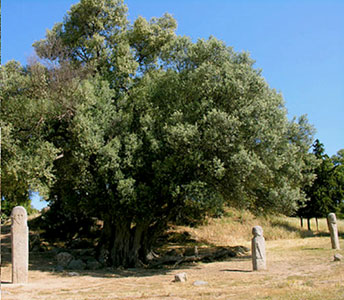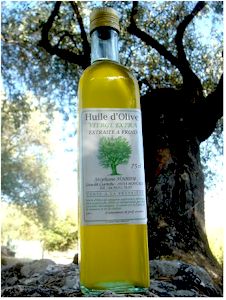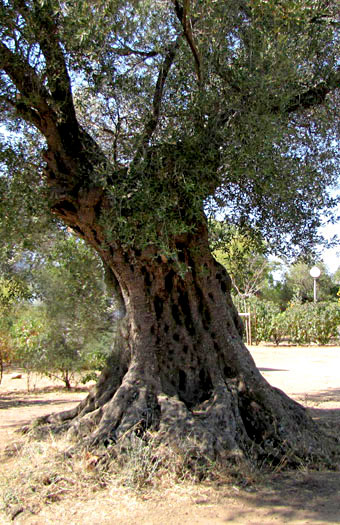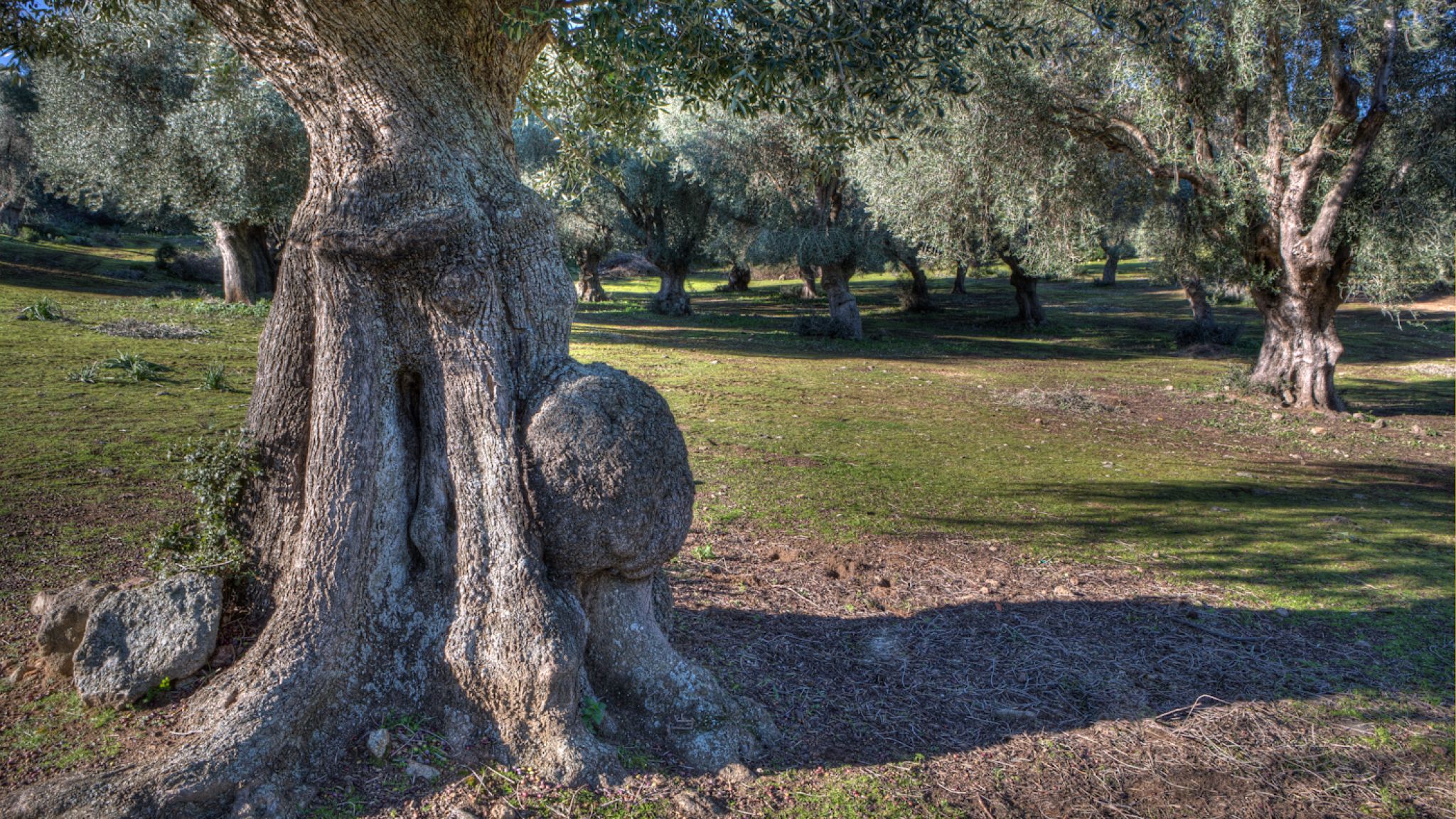THE OLIVE-TREE
 In Corsica you'll find very old traces of the use of the olive-tree.
In Corsica you'll find very old traces of the use of the olive-tree.
It goes back to 3400 B.C. where they found baskets with olive stones in the Scaffa-cave near St. Florent.
One supposes that oil-mills have existed since about the midst of the Neolithicum, according to the principle of
extorsion by turning. The oldest until then were those in Egypt( 22-27 centuries B.C.).
The olive-tree is endemic in the Corsican maquis.
They are very old time-honoured trees. Some of them are more than 2000 years old, with a height up to 20 meters, often
growing on poor soil.
The history of the olive-tree fits in with the foundation of Corsican culture. Symbol of peace, mythology tells us, that
it was an olive-branch brought to Noah by a dove to indicate that peace and hope would come back on
earth (see also Bible: Genesis 8: 10,11).
It was the goddess Athena, who did grow the olive-branch in the soil. Athena chose the olive-branch as the most
useful thing to mankind. To become a strong long living tree with edible fruits, able to provide irreplaceable oil
to prepare food, soften wounds, giving force to human organism, providing light in the night.
She won the battle between her and Poseidon, to think of the most useful thing, so she got the favour of Zeus and
gave her name to the town: Athens.
And what was the symbol of the Olympic Games in Athens in 2004? The olive-tree and its branch, of course!
The olive-tree is a mystic tree all over the Mediterranean area.
In Corsica its oil is also used against what they call
l'occhiu, the Evil Eye. Why The Eye? Without any doubt because
the look is the most common form of the Envy:
invidia, of the conscious and unconscious desire.
L'occhiu can be exorcied by words, or attitude, but also by a ritual, well-known in Corsica: the
incantesimu,
practised by the
Signadori (
see Signadori, part 4, Dorothy Carrington).
Corsica has huge areas with oliveyards, with trees up to 20 meters in height.
The olive-culture dates from Antiquity, with his specific qualities. The tree develops a harmony with his surroundings
and the harvest takes place by the natural fall of the fruit, every two years, from October until the beginning of the
summer. The very ripe olives are gathered, rumpled. You can already eat them, with a softer taste, less sharp.

Every microregion has its own sort of olive.
In the Balagna, where the oil tradition is the strongest, without any doubt, there are trees of sometimes 2000 years, one
above the other, between 10 and 450 meters in dense oliveyards, along cultivated parcels or on terrasses.
Terrible fires, so feared in Corsica, destroyed a lot of oliveyards in 1957 and in 1985.
The fruits of the sort Sabina, in the Balagna, are very rich in oil. In the Nebbiu, near
St. Florent, the Biancaghja is the most important: the quantity of oil is often more
than a third of the weight of the fruit. These are very old trees too, they often reach more than 14 meters in circumference.
In the Tallanais, between Propriano and Sartène you find the Ghjermana, which can
endure cold temperatures. They give a coloured oil.
The trees of sometimes only some centuries old, grow above each other, between 300 and 550 meters.
At last in the region of Sollacaro, in the midst of the dense oil-zone between Bonifacio and Ajaccio, the beautiful
glossy black Zinzala is the most important one.
Everywhere in Corsica, the olive-culture has made a restart.
In the original productive regions: Balagna, Nebbiu, Taravo, Rocca and Alta Rocca, they have always been famous for their
extent and the quality of their oliveyards. The old trees are cleaned, pruned, brought into productivity. The soil is
cleaned. New trees are planted by the younger people, who came to live there. The oliveyards know a rebirth and an
enormous development, with an actual area of about 2000 hectares (600 in 1990).
Besides the olive-growers have joined their efforts in the SIDOC( Syndicat Interprofessionnel des Oléiculteurs
Corses) to replant a.o. 1200 hectares of new parcels, 900 in Haute-Corse.
The techniques have evolved - nets are placed under the trees, so that the olives can't reach the soil, reducing the
acidity and sharpness quite a lot; the quality of pressing and storage are improved.
But the respect for and the fidelity to the ancestral values are still there. To produce an oil of high quality, typical,
specific for the Ile de Beauté.
You shouldn't miss the two most important yearly manifestations:
- A Festa di l'Oliu Novu in Santa-Lucia-di-Tallano, in March
- A Fiera di l'Alivu in Montegrosso (Montemaggiore, Lunghignano, Cassano
at the foot of the Monte Grosso, 1938 m) in July
which mark the important periods of the oil-calendar of the island.
This is the opportunity to meet the growers of the island, but also to taste other local specialities and last but
not least to lay in your oil-provisions.

Moreover the Corsican artists make splendid pieces of art and articles for household purposes, like dishes, spoons
and so on, from the olive-wood.

The Fiera (Fair) di l'Alivu, ia always a great success. The recognition of the
Corsican oil by the label AOC (see under) played it's part of course. 55 Growers and artists were present with
their stands. On the programme a.o.: information on olive-oil - demonstration of pruning olive-trees - Cucina Corsa:
Corsican cooking with olive-oil - guided visits - traditional music and dance (Tutti in Piazza) - Corsican singing by
I Rusulaghji.
After many years of hard work in the oil-culture, the olive-oil of Corse-Oliu di Corsica has obtained its AOC: Appellation d'Origine Contrôlée, indication of the best quality. A great satisfaction!
It means the recognition of years of hard work by the growers, on the sector, that was abandoned after the Second World War, until the seventies.
Six varieties have been recognized AOC:
Zinzala (Corse du Sud),
Ghjermana d'Alta Rocca,
Sabina (Balagna),
Capanaccia (Cap Corse),
Ghjermana di Casinca and
Curtinese (Centre Corse).
They will all have the possibility to obtain the AOC.
The typical quality of the Corsican oil is, that the fruits must be collected very ripe to give a golden oil with a
soft taste, some sorts a tiny bit bitter and sharp.
You find oil with an aroma: maquis, vegetables, noisettes or almonds, as well as an aroma: straw, artichoke, courgette,
myrte or honey.
The Corsican people are very fond and very proud of the natural richness of their island, the beauty of their
landscapes, the specific flora and fauna, which they want to protect as much as they can. So in a lot of their
famous music, nature plays a role.
I can't leave you without the text of the Lamentu di l'Alivu.
The tree is very unhappy because they will cut it down and addresses the following words to the Corsican, who is
going to do it.
Poem written in 1956 by Paul Lorenzi, mayor of Sullacaro in the southern part of Corsica, but also a renowned
tale-teller, this complaint has become popular thanks to Charles Foata or "Tappa". The text is from the manuscript
of the poet, although with three strophe missing.
Words: Paul Lorenzi, music: Charles Foata, arrangements: Benedettu Sarocchi.
Sung by the group Sarocchi on their CD: Orígine
Lamentu di l'Alivu |

|
O lu meu lu destinu
Com'eddu hè triste è mischinu;
Sogu torru à chì ni vole
Si ni spassanu le piole;
Oghje nun ai pìu cura
O Corsu di a me cultura.
|
Oh my poor destiny
How sad and miserable it is;
I have fallen back to the wild state
And I suffer the axe.
Today there's little you care for
Oh Corsican, of my culture. |
| |
|
Di a me pianta cusì degna
Sè ghjuntu à fanni la legna
E par fatti ni lu focu,
O chì scandalu di locu!
Lasci crescia machja è flettu
E t'attacchi à l'alivetu. |
You have made firewood from
My so dignified plant,
What a shame!
You spare the maquis
And the fern
And you attack the oliveyard. |
| |
|
Purtantu, s'tù ti n'inveni,
Avii sgiarri belli pieni;
Mi cuddii anc'à lu terzu
E mi vindii à bon' prezzu;
Nun timii malannata
Dopu la raccolta fatta. |
Still, if you do remember,
Your jars were well filled.
You gathered more than your share
And sold me for a good price.
You didn't fear the shortage anymore
Once the harvest was done. |
| |
|
U me oglio cusì finu
Oghje nun ni vol'pìu nimu;
Compri l'oglio in butteglia
Chì ti veni da Marseglia;
Sè ingranditu è senza narba
E t'imbuffi à l'ogliu d'arba. |
Nobody wants anymore
From my exquisite oil;
You buy the oil in bottles
Oil, that comes from Marseille
You grew up without force
Fat from oil of weeds. |
| |
|
Nun ai di li maiori
Nè lu stintu nè lu core;
Nun voli pìu fà niente,
T'ai in capu lu cuntinente,
Cridendu di fà furtuna
Senza fatica alcuna. |
You have neither the instinct,
Nor the heart of your older ones.
You don't want to do anything more,
You are dreaming of the Continent
Believing that you will make fortune
Without any effort. |
| |
|
A me rama di a pace,
U me fruttu di a luce,
Eiu, l'alburu di Diu,
Prima eru lu to invidiu;
Oghje mancu pì lu vitu
Nè menu lu benedittu. |
My olive-branch of peace,
My fruit of the light,
I, tree of God,
Excited envy;
Today I'm absent from the meal
And even from the benediction. |
| |
|
O Corsu, ciò che tù faci,
Oghj'ella ti vaghi in paci!
Miritarìa pìu d'amore
Eiu di tantu valore;
Ma di avemmi abattutu
Un ghjornu sarè pintutu! |
Oh Corsican, what are you doing,
Leave it alone!
I, having so much value,
I should have deserved more love;
But that you cut me down
You will regret one day! |
|
Yvonne Peters
August 2004
Sources:
. Articles of the Fieru di l'Alivu, Montegrosso, 2003/2004
. Méditerranée-Magazine: 1997, E.M.: L'Olive, reine de l'Ile de Beauté
. Méditerranée-Magazine : 2003, Jean Casanova/Christian Andreani:Toutes les Couleurs de l'Huile d'Olive
. Corse-Matin 24 juin 2004: Mario Grazi: L'Oliu d'Alivu a son AOC
. Corse-Matin 18 juillet ": La XVIe Fiera di l'Alivu; L'Olivier célébré à Montemaggiore
. Corse-Matin 19 juillet ": L'Année du label per A Fiera di l'Alivu
. Sarocchi: CD Orígine with: U Lamentu di l'Alivu

www.oliudicorsica.fr
 In Corsica you'll find very old traces of the use of the olive-tree.
In Corsica you'll find very old traces of the use of the olive-tree.



